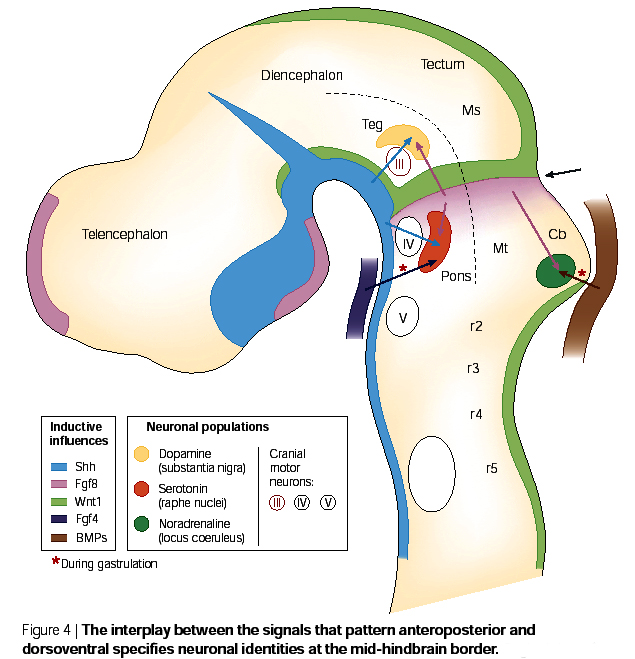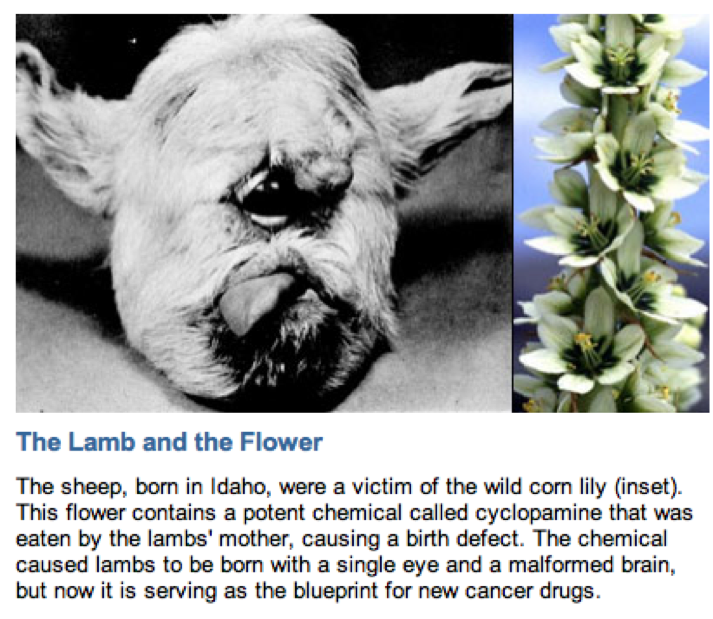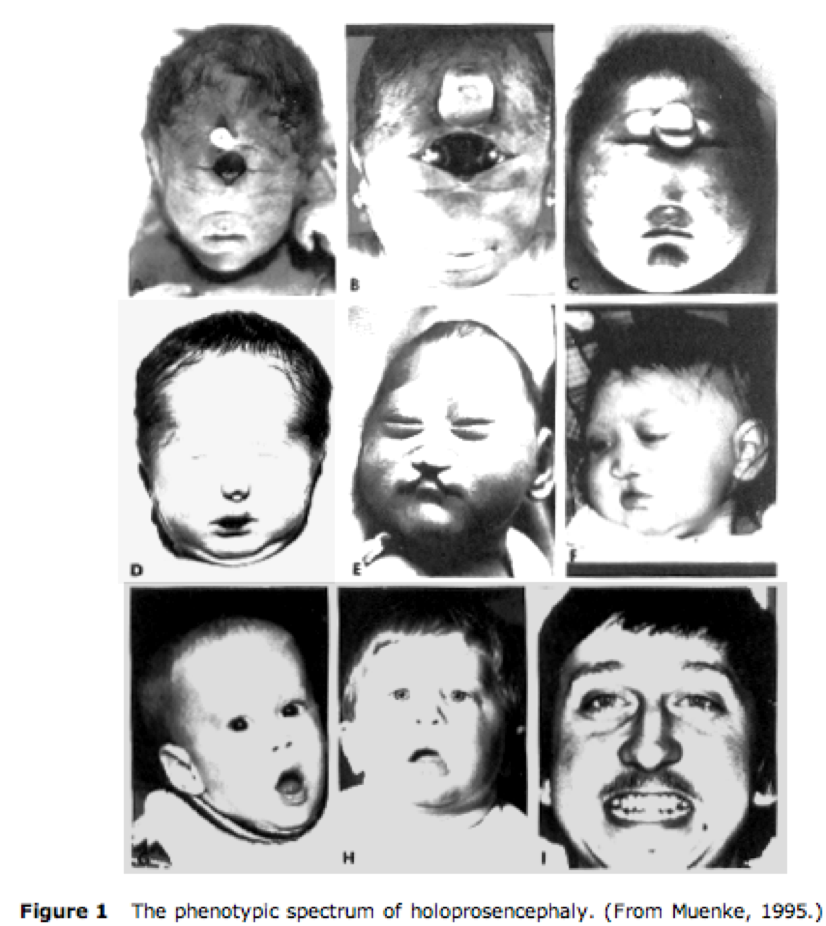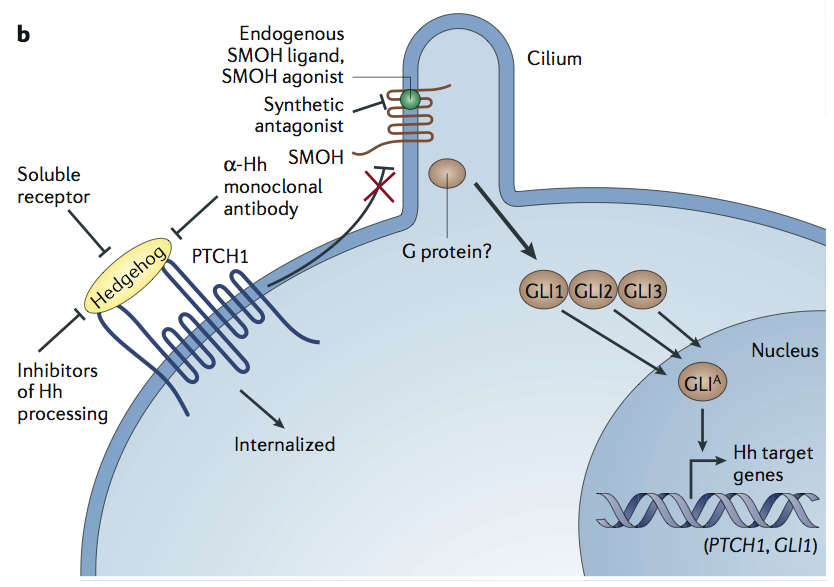



The Curious Case of The One-Eyed Sheep
Matthew Herper, 11.28.05
How a freakish birth defect among Idaho lambs 50 years ago has led to a powerful new cancer treatment.
Idaho sheep ranchers couldn't figure out why, in the decade after World War II, a random batch of their lambs were being
born with strange birth defects. The creatures had underdeveloped brains and a single eye planted, cyclopslike, in the
middle of their foreheads. In 1957 they called in scientists from the U.S. Department of Agriculture to investigate.
The scientists worked for 11 years to solve the mystery. One of them, Lynn James, lived with the sheep for three
summers before discovering the culprit: corn lilies. When the animals moved to higher ground during droughts, they
snacked on the flowers. The lilies, it turned out, contained a poison, later dubbed cyclopamine, that stunted developing
lamb embryos. The mothers remained unharmed. The case of the cyclopamine and the one-eyed Idaho lambs remained
a freakish chemistry footnote for the next 25 years; researchers never could uncover why cyclopamine caused birth
defects.
But now cancer researchers have improbably seized on the obscure plant chemical as the blueprint for a half-dozen
promising tumor-fighters. Cyclopamine, it turns out, blocks the function of a gene called Sonic hedgehog that is essential
for embryonic development but also plays a lead role in causing deadly cancers of the pancreas, skin, prostate and
esophagus. "It's a beautiful accident of evolution," says Philip A. Beachy, a Howard Hughes Medical Institute investigator
at Johns Hopkins University and one of the key players in this genetic detective story. In early tests researchers have
stopped the growth of the most virulent human tumors, varieties accounting for 25% of cancer deaths.
Genentech and partner Curis, a fledgling biotech in Cambridge, Mass., are first out of the gate with an experimental
hedgehog-blocking skin cream for basal cell skin cancer. More drugs in the pipeline are aimed at other cancers. Julian
Adams, the superstar chemist who invented the AIDS drug Viramune and cancer drug Velcade, has made a hedgehog
inhibitor one of his lead medicines at Infinity Pharmaceuticals. Little is known about his drug, which has not yet entered
human trials, but on its Web site Infinity points to the role of hedgehog in pancreatic cancer. Novartis, Abbott Laboratories
and Boehringer Ingelheim are all thought to be pursuing hedgehog programs. "It would be a major triumph for basic
science if a drug were to come from this,"says Matthew Scott, an HHMI cancer genetics expert at Stanford University.
The discovery of the hedgehog genetic pathway originated in the quest to understand how an embryo knows what body
parts to grow and where. A developing embryo starts out as a ball of identical cells with no top or bottom, no front or
back. No one knew how this ball of cells figures out where to put an arm, a wing, a head or a foot.
In the late 1970s researchers Christiane Nüsslein-Volhard and Eric Wieschaus completed their massive study of
thousands of fruit-fly mutations, a landmark in large-scale biological analysis. They found 50 genes that turned out to be
very important to the development of fly embryos. One that they mutated caused the flies to grow a coat of spines all over
their undersides, so they dubbed it the hedgehog gene. (The two won the Nobel Prize in 1995 for this work.)
That set off a search by Philip Beachy and a dozen others to explore the hedgehog pathway in higher-order animals such
as fish and mammals. They found several in each species, whereas flies have only one. In mammals, the most important
may be the Sonic hedgehog gene, named after the Sega videogame character by scientists in the Harvard laboratory of
Clifford Tabin in 1993. Mutations of Sonic hedgehog in people may result in babies with a single eye or a hole in the
center of their head. The infants' brains can be so underdeveloped that they often don't survive. Usually patients have less
serious mutations: a single front tooth or a slightly deformed face.
If Sonic hedgehog is mutated when a mouse is growing its paws, the animal won't grow digits. Interfere with it when the
developing brain is casting out the two bulges of nerve tissue that become the eyes, and you get cyclopean sheep. "It's
spectacular," says Frederic de Sauvage, a hedgehog researcher at Genentech.
All these mutations were done by physically changing the animals' DNA. It wasn't until Johns Hopkins' Beachy and his
colleagues remembered reading about the Idaho lambs that they realized cyclopamine could be used as an easier on-off
switch for the hedgehog pathway. They published their discovery in 1998, and Beachy and others began exposing
animals to cyclopamine to study its role.
Matthew Scott of Stanford and a team at UC, San Francisco, working separately, made a huge connection: Defects in
hedgehog or related genes were present in two rare diseases linked to cancers. One, called Gorlin's syndrome,
sometimes causes basal cell skin cancer to blanket patients as soon as they hit puberty. A second, called
medulloblastoma, afflicts the brains of nearly 400 children a year in the U.S., often fatally. Normally the hedgehog gene is
dormant in adults. But Beachy theorized it is needed to make repairs in parts of the body that undergo constant
regeneration, as in chronic acid reflux, where Sonic hedgehog works overtime to reline the throat. When the gene's activity
goes awry in places like the lungs and skin, it can lead to tumors. Beachy has turned normal prostate cells cancerous with
a single mutation in Sonic hedgehog. "This pathway has more quirks and twists than you can imagine," says Beachy.
"Now the evidence is really expanding."
Hedgehog signalling pathway and Shh in cell cycle regulation.





Hedgehog signalling pathway and Shh in cell cycle regulation.













